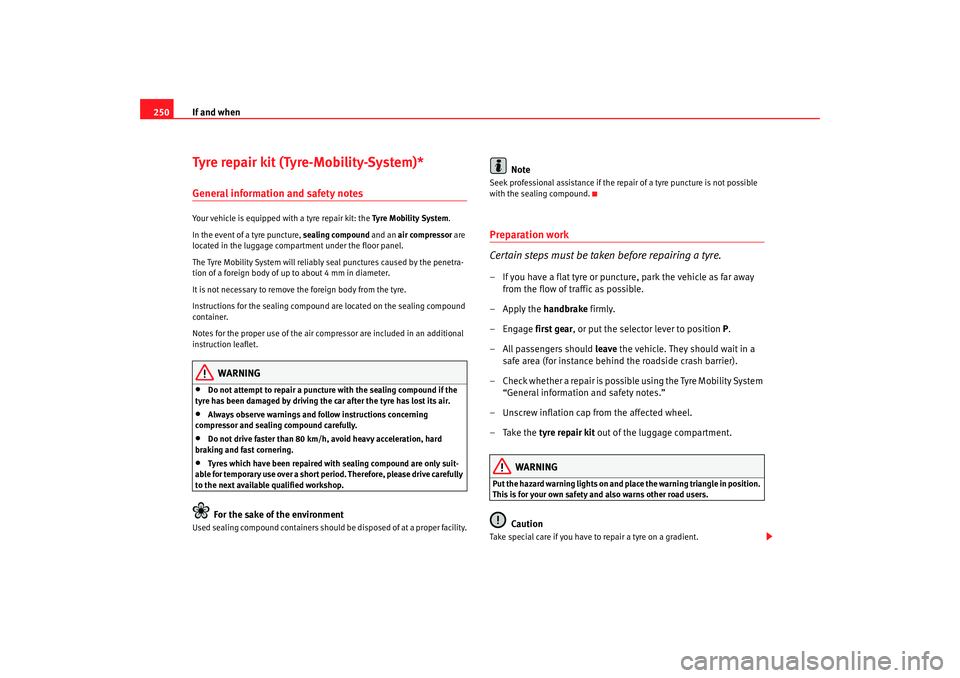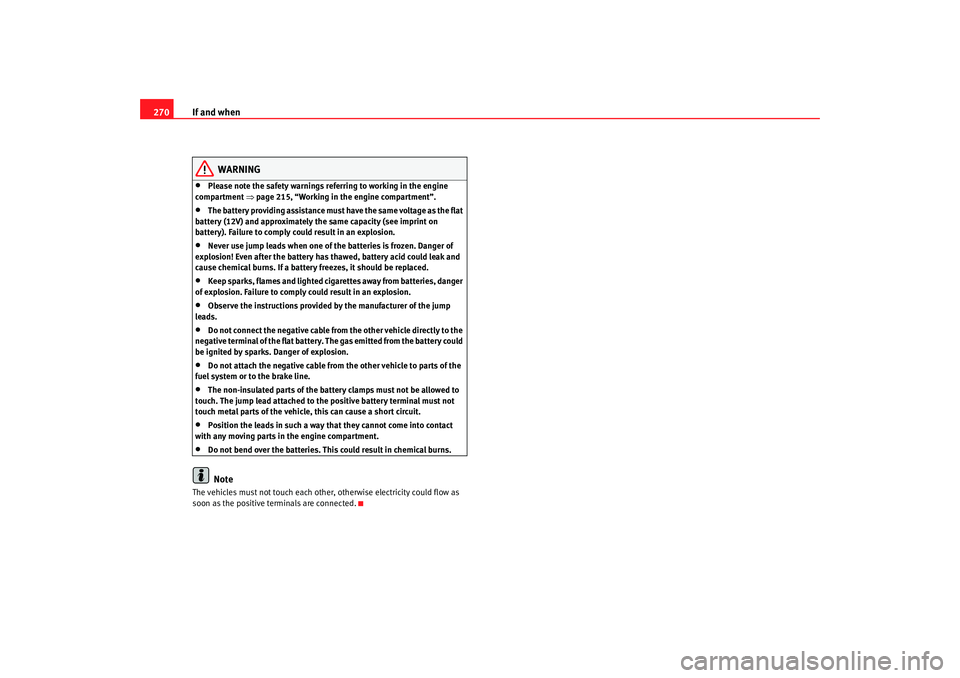Page 230 of 317

Checking and refilling levels
228If this is not sufficient, refer to a qualified workshop.
WARNING
Do not drive unless you have good visibility through all windows!•
Clean the windscreen wiper blades and all windows regularly.
•
The wiper blades should be changed once or twice a year.Caution
•
A damaged or dirty window wiper could scratch the rear window.
•
Never use fuel, nail varnish remover, paint thinner or similar products to
clean the window.
•
Never move the windscreen wiper by hand. This could cause damage.
Brake fluidChecking the brake fluid level
The brake fluid is checked at the intervals given in the service
schedule.– Read off the fluid level at the transparent brake fluid reservoir. It should always be between the “MIN” and “MAX” marks.The position of the brake fluid reservoir is shown in the corresponding engine
compartment diagram ⇒page 279. The brake fluid reservoir has a black and
yellow cap.
The brake fluid level drops slightly when the vehicle is being used as the
brake pads are automatically adjusted as they wear.
Fig. 172 In the engine
compartment: Brake fluid
reservoir cover
altea_XL ingles.book Seite 228 Donnerstag, 13. September 2007 10:36 10
Page 245 of 317

If and when243
Safety First
Operating instructions
Tips and Maintenance
Te c h n i c a l D a t a
Note
•
Seek professional assistance if the repair of a tyre puncture is not
possible with the sealing compound.
Wheel changePreparation work
What you must do before changing a wheel.– If you have a flat tyre or puncture, park the vehicle as far away from the flow of traffic as possible. Choose a location that is as
level as possible.
– All passengers should leave the vehicle. They should wait in a safe area (for instance behind the roadside crash barrier).
– Switch off the engine. Switch on the hazard warning lights.
–Apply the handbrake firmly.
–Engage the first gear, or put the selector lever to position P for
those vehicles with an automatic gearbox.
– If you are towing a trailer, unhitch it from your vehicle.
–Take the vehicle tools and the spare wheel out of the luggage
compartment.
WARNING
Put the hazard warning lights on and place the warning triangle in position.
This is for your own safety and also warns other road users.
Caution
If you have to change the tyre on a gradient, block the wheel opposite the
wheel being changed by placing a stone or similar object under it to prevent
the vehicle from rolling away.
Note
Please observe legal requirements when doing so.Changing a wheelChange the wheel as described below
–Pull off the hub cap . Also refer to ⇒page 244.
–Slacken the wheel bolts.
– Raise the car with the jack in the corresponding zone.
– Ta k e o f f the wheel and then put on the spare wheel.
– Lower the vehicle.
– Tighten the wheel bolts firmly i n d i a go na l s e q u e n ce wi t h t h e b ox
spanner.
–Replace the hub cap.
altea_XL ingles.book Seite 243 Donnerstag, 13. September 2007 10:36 10
Page 252 of 317

If and when
250Tyre repair kit (Tyre-Mobility-System)*General information and safety notesYour vehicle is equipped with a tyre repair kit: the Tyre Mobility System.
In the event of a tyre puncture, sealing compound and an air compressor are
located in the luggage compartment under the floor panel.
The Tyre Mobility System will reliably seal punctures caused by the penetra-
tion of a foreign body of up to about 4 mm in diameter.
It is not necessary to remove the foreign body from the tyre.
Instructions for the sealing compound are located on the sealing compound
container.
Notes for the proper use of the air comp ressor are included in an additional
instruction leaflet.
WARNING
•
Do not attempt to repair a puncture with the sealing compound if the
tyre has been damaged by driving the car after the tyre has lost its air.
•
Always observe warnings and follow instructions concerning
compressor and sealing compound carefully.
•
Do not drive faster than 80 km/h, avoid heavy acceleration, hard
braking and fast cornering.
•
Tyres which have been repaired with sealing compound are only suit-
able for temporary use over a short period. Therefore, please drive carefully
to the next available qualified workshop.For the sake of the environment
Used sealing compound cont ainers should be disposed of at a proper facility.
Note
Seek professional assistance if the repair of a tyre puncture is not possible
with the sealing compound.Preparation work
Certain steps must be taken before repairing a tyre.– If you have a flat tyre or puncture, park the vehicle as far away
from the flow of traffic as possible.
–Apply the handbrake firmly.
– Engage first gear, or put the selector lever to position P.
– All passengers should leave the vehicle. They should wait in a
safe area (for instance behind the roadside crash barrier).
– Check whether a repair is possible using the Tyre Mobility System “General information and safety notes.”
– Unscrew inflation cap from the affected wheel.
–Take the tyre repair kit out of the luggage compartment.
WARNING
Put the hazard warning lights on and place the warning triangle in position.
This is for your own safety and also warns other road users.
Caution
Take special care if you have to repair a tyre on a gradient.
altea_XL ingles.book Seite 250 Donnerstag, 13. September 2007 10:36 10
Page 257 of 317
If and when255
Safety First
Operating instructions
Tips and Maintenance
Te c h n i c a l D a t a
20
Park Pilot (Parking assistant) / Gear lever/ ESP switchboard 10
21 Cable control unit 7,5
22 Volumetric alarm sensor/ Alarm horn 5
23 Diagnosis / Rain sensor / Light switch 10
24 Vacant
25 Switchboard coupling automatic gearbox 20
26 Vacuum pump 20
27 RSE input (roof screen) 10
28 Rear wiper motor / Switchboard wiring 20
29 Vacant
30 Cigarette lighter / socket 20
31 Vacant
32 Vacant
33 Heater 40
34 Vacant
35 Vacant
36 Engine management 10
37 Engine management 10
38 Engine management 10
39 Trailer control unit (coupling) 15
40 Trailer control unit (indicators, brakes and left side) 20
41 Trailer control unit (fog light, reversing light and right side) 20
42 Vacant
43 Trailer pre-installation 40
Number
Consumer Amperes
altea_XL ingles.book Seite 255 Donnerstag, 13. September 2007 10:36 10
Page 260 of 317
If and when
258
19 Clean 30
20 Vacant
21 Lambda probe 15
22 Brake pedal, speed sensor 5
23 Engine management
5
Engine management 10
Engine management 15
24 ARF, gearbox valve 10
25 Right lighting 40
26 Left lighting 40
27 Engine management
40
Engine management 50
28 Ignition key 40
29 Electric windows (front and back)
50
Electric windows (front) 30
30 Ignition key 40
Number
Consumer Amperes
altea_XL ingles.book Seite 258 Donnerstag, 13. September 2007 10:36 10
Page 265 of 317
If and when263
Safety First
Operating instructions
Tips and Maintenance
Te c h n i c a l D a t a
Side lights–Raise the bonnet.
– Remove the cover ⇒fig. 191 by pulling on this. – Extract the lamp holder
⇒fig. 192 outwards.
– Replace the bulb by pulling this out and inserting the replace- ment.
– Installation is done in the reverse order.
Rear lights•
On the body
- Indicator, side and brake light
•
On the tailgate
- Left hand side: position and antifog.
- Right hand side: reverse and position.
Fig. 191 Side lightsFig. 192 Side lights
AD
A1
altea_XL ingles.book Seite 263 Donnerstag, 13. September 2007 10:36 10
Page 266 of 317
If and when
264Indicator, side and brake lights on the bodywork– Remove the cover of the luggage compartment lateral panel
⇒fig. 193. – Turn the lampholder to the left
⇒fig. 194.
– Extract the failed bulb and change it for a new one.
– To refit follow the steps in reverse order, taking special care when fitting the lamp holder.
Fig. 193 Lights on
vehicle bodyFig. 194 Lights on
vehicle body
altea_XL ingles.book Seite 264 Donnerstag, 13. September 2007 10:36 10
Page 272 of 317

If and when
270
WARNING
•
Please note the safety warnings referring to working in the engine
compartment ⇒page 215, “Working in the engine compartment”.
•
The battery providing assistance must have the same voltage as the flat
battery (12V) and approximately the same capacity (see imprint on
battery). Failure to comply could result in an explosion.
•
Never use jump leads when one of the batteries is frozen. Danger of
explosion! Even after the battery has thawed, battery acid could leak and
cause chemical burns. If a battery freezes, it should be replaced.
•
Keep sparks, flames and lighted cigarettes away from batteries, danger
of explosion. Failure to comply could result in an explosion.
•
Observe the instructions provided by the manufacturer of the jump
leads.
•
Do not connect the negative cable from the other vehicle directly to the
negative terminal of the flat battery. The gas emitted from the battery could
be ignited by sparks. Danger of explosion.
•
Do not attach the negative cable from the other vehicle to parts of the
fuel system or to the brake line.
•
The non-insulated parts of the battery clamps must not be allowed to
touch. The jump lead atta ched to the positive battery terminal must not
touch metal parts of the vehicle, this can cause a short circuit.
•
Position the leads in such a way that they cannot come into contact
with any moving parts in the engine compartment.
•
Do not bend over the batteries. This could result in chemical burns.Note
The vehicles must not touch each other, otherwise electricity could flow as
soon as the positive terminals are connected.
altea_XL ingles.book Seite 270 Donnerstag, 13. September 2007 10:36 10